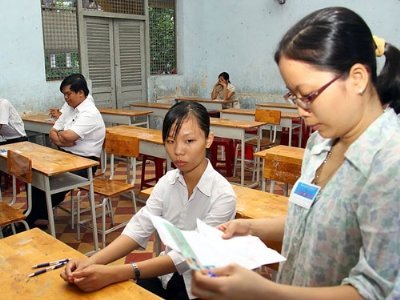Vietnam is seriously lacking manpower in some professions, while it has many redundant workers in other fields.

Students prepare for the university entrance exam
In 2007, the government set up a long term program on the human resource development by 2020, which says that Vietnam needs qualified workers in basic sciences and technologies. However, the training has been going not in accordance with the program.
Under the program, the government prioritizes to develop some natural and social sciences, information technology, mechatronics technology and automation, biotechnology, and some technological branches that can meet the requirements for the industrialization and modernization. The government also emphasized the need of training teachers and highly qualified experts in the service sector.
The government requested to adjust the structure of students so as to obtain the balanced development of the manpower, with nine percent of manpower in basic sciences, 12 percent in pedagogical branches, 35 percent in technologies, 9 percent in agriculture, forestry and fisheries, 6 percent in healthcare, 20 percent in economics and laws, and 9 percent in others.
The program pointed out that by 2020, the professions which need high manpower demand would include industries, construction and services.
It is expected that by 2015, transport, tourism and information technology would be the sectors that need the highest numbers of workers with 500,000 workers for each. Meanwhile, the banking sector, which is now considered the “hottest” job now, would need some 240,000 people only.
Especially, the finance sector is believed to need 2.2 million officers in 2011-2015, but the number would drop to 1.6 million in 2016-2020.
As such, the demand for the manpower in the finance and banking sector would not be as hot as currently, while the demand would see a gradual decrease from 2016.
The imbalanced training
It’s clear that the training plans drawn up by the schools do not go in line with the government’s programming and the career forecasts. The schools tend to expand the training scale in some majors which are considered the hot and fashionable ones, while do not care much about the manpower demand.
The noteworthy thing is that though the Ministry of Education and Training (MOET) has realized the problem, it has not tried to stop it.
According to the ministry, 248 out of 416 universities and junior colleges, or 59.62 percent, last year enrolled students for one of the four economics-relating majors: economics, business administration, finance and banking, and accountancy.
Meanwhile, only 76 universities (4-5 year training|) and 92 junior colleges (3 year training) which specialize in training art students and some pedagogical schools did not enroll students for the above said majors.
Also according to the ministry, 38 percent of the enrolment quota was allocated to the four majors, while the remaining 62 percent was allocated to all other training majors.
In 2009-2011, the number of students registering to attend the university entrance exams to the four majors accounted for 41 percent of the total number of examinees.
Though admitting that there are too many economics students, the ministry still allocated the highest quota for economics relating majors. 32 percent of the total 576,000 popular training students in 2012 would be the ones in economics, finance and banking. Meanwhile, 30 percent of the training quota has been allocated to technological majors, 9 percent to natural and social sciences.
MOET’s Deputy Minister Bui Van Ga admitted that less and less students want to study social sciences. In 2010, the number of students registering to attend the exams to social sciences and humanity majors amounted to 7.8 percent (the students have to take C-group exams, i.e. literature, history and geography), while the figure dropped to 6.4 percent in 2011.

Leave your comment on this story